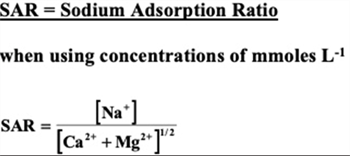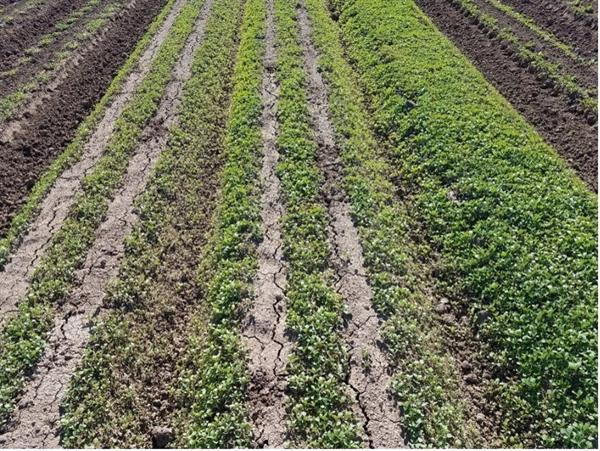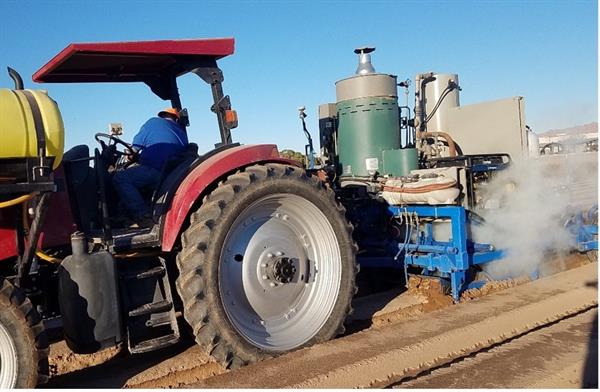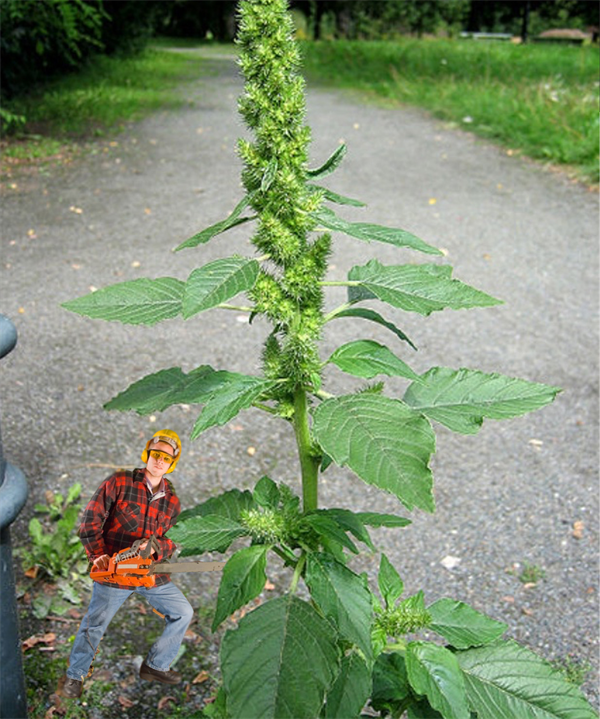
In the late 19th and early 20th centuries, as people moved out to settle the open territories of the western U.S., the development of lands for agriculture was a primary objective. However, they encountered problems with lands and soils that were sometimes found to be unsuitable for irrigation and crop production, often due to salinity, sodicity, and drainage problems. It was immediately recognized that much of the land and soils in the western U.S. needed to be “reclaimed” from their natural condition. The “reclamation” of these lands became an important part of the process. All this development was dependent on the availability of water and good land and water management capacities. This required large tracts of land and large projects. As a result, the U.S. federal government became involved in the development of these western territories.
In response to these needs in the western U.S. territories, the Reclamation Act and the U.S. Reclamation Service (USRS) was formed within the US Geological Survey under the Secretary of the Interior Ethan Allen Hitchcock when Theodore Roosevelt signed The Reclamation Act on 17 June 1902. The new USRS was given the responsibility of studying potential water development projects in each western state with federal lands. In 1907, the Secretary of the Interior separated the USRS from the USGS and created the Bureau of Reclamation (BoR) as a distinct entity within the Department of the Interior.
Along with the USRS and BoR, the U.S. Department of Agriculture (USDA) sent agronomists (crop and soil scientists) out into the western territories to study the soils and climate to find crop plants that were well-suited for adaptation. Colleges of Agriculture with the Land Grant Universities, such as the University of Arizona, were also involved in this process.
In the arid and semi-arid regions of the western U.S. soils were commonly saline from the accumulation of soluble salts due to low rainfall and high evaporation demand from the climate. Most of the soils suitable for crop production agriculture, such as in Arizona, are alluvial soils (deposited over time by water associated with rivers and streams) that are young geologically and very fertile and productive once they are reclaimed from salinity and sodicity. Salts had accumulated in these soils due to water being drawn out of the soils through evaporation. This repeated action over long periods of time resulted in high concentrations of soluble salts deposited in the upper portions of the soil profile. Soils were classified in terms of the salinity levels and today we commonly use the electrical conductivity (EC) of the soil solution as a standard measure. That is because solutions increase in electrical conductivity as the solute concentration, or salinity increases. The measure of EC is used for water (ECw) and the soil solution or soil saturation extracts (ECe).
The international (SI) unit of conductivity is ‘Siemens’ with the symbol ‘S’ per meter. The equivalent non-SI unit is ‘mho’ and 1 mho = 1 Siemens. Thus, for those not familiar with the SI system, mmhos/cm can be read the same as dS/m without any numerical change. The use of mmhos/cm is still found with some laboratories and references.
By definition a saline soil is a non-sodic soil containing sufficient soluble salt to adversely affect the growth of most crop plants with a lower limit of electrical conductivity of the saturated extract (ECe ) being 4 deciSiemens / meter (dS/m) or greater, which is equivalent to a value of 4 mmhos/cm . It is important to note that this is a lower limit by definition but the degree of soil salinity conditions are fully dependent upon the crop in question. Crop plant sensitivity to salinity varies tremendously among species (Tables 1 and 2).
|
Soil Salinity Class |
Conductivity of the Soil Saturation Extract ECe(dS/m) |
General Effect on Crop Plants |
|
Non-saline |
0-2 |
Salinity effects negligible |
|
Slightly saline |
2-4 |
Yields of sensitive crops may be restricted |
|
Moderately saline |
4-8 |
Yields of many crops are restricted |
|
Strongly saline |
8-16 |
Only tolerant crops yield satisfactorily |
|
Very strongly saline |
>16 |
Only a few tolerant crops yield satisfactorily |
Table 1. Soil salinity classes and crop growth.
Arid land soils are commonly naturally saline due to the process of soluble salt accumulations over long periods of time. Also, the rivers, streams, and aquifers used for irrigation also commonly carry significant concentrations of soluble salts. Dr. Wilford Gardner, one of my predecessors, colleagues, and friend from the UA, once state that “Successful irrigation schemes in arid regions carry the seeds of their own demise”. This refers to the natural salinity of irrigation waters that will result in damaging salt accumulations over time if not managed properly.
Irrigation waters in Arizona commonly carry significant salt loads. As an example, by use of a simple conversion factor of 2.7 we can convert the concentration of any given solute in water to pounds (lbs.) of that solute delivered in each acre-foot (AF) of water. The following example uses water with a total solute (salt) concentration of 750 parts per million (ppm or mg/l), which is similar to Colorado River water quality. We can see that delivering five AF of this irrigation water in a single season delivers five tons of salt into that field. As a result, we must deal with this constant salt delivery in desert crop production systems.
Example: Solute Concentration (ppm) X 2.7 = lbs. of solute/AF-water
750 ppm X 2.7 = 2,032.5 lbs. salt/AF
2,032 lbs. salt/AF X 5 AF-water = 10,162.5 lbs. salt/acre
= (5.0 T salt/acre)
For the reclamation and management of soluble salts in a soil profile, leaching and the downward movement of the soluble salts through the crop root zone is the effective procedure needed. Leaching is accomplished by applying additional amounts of irrigation water to a soil profile that is already saturated. Leaching and the removal of soluble salts is effective when the soil-water moves below the root zone and good internal soil drainage carries the salts out of the soil-plant system in the field. Therefore, movement of water through the soil profile and root zone and good internal soil drainage are essential elements to this process of soil reclamation and management. Soil amendments are not needed for saline soil management. Additional water for salt leaching is needed.
A common question is “how much additional water is needed to accomplish sufficient leaching?”. That is primarily dependent on the crop and the salinity level of the irrigation water. An effective and straightforward method of calculating a leaching requirement (LR) can be calculated with the following equation that was presented by the USDA Salinity Laboratory (Ayers and Westcot, 1989).
Leaching Requirement (LR) Calculation:
Where:
ECw = salinity of the irrigation water, electrical conductivity (dS/m)
ECe = critical plant salinity tolerance, electrical conductivity (dS/m)
This is a good method of a LR calculation that has been utilized extensively and successfully in Arizona and the desert Southwest for many years. We can easily determine the salinity of our irrigation waters (ECw) and we can find the critical plant salinity tolerance level from easily available tabulations of salinity tolerance for many crops (Ayers and Westcot, 1989). Additional direct references are from Dr. E.V. Maas’ lab at the University of California (Maas, 1984: Maas, 1986; Maas and Grattan, 1999; Maas and Grieve, 1994; and Maas and Hoffman, 1997).
There are many methods to calculate the proper LR and the one shown here (Ayers and Westcot, 1989) is good in my view because it includes the specific salinity limits for the crop and salinity levels of the irrigation water. Also, it is very simple and straightforward to use and apply.
For example, we can see in Table 2 from a few selected crops commonly grown in Arizona the variation in salinity tolerance. For a given quality of water (ECe) the LRs calculated from the equation above will increase with lower salinity tolerance levels. For example, lettuce will require a higher LR than cotton or barley using the same water for irrigation.
Table 2. Salinity tolerance for selected crops with soil solution salinity levels (ECe, dS/m at 25oC) where yields will be reduced by 10, 25, and 50%.
|
Crop |
10% |
25% |
50% |
|
Lettuce (Latuca sativaL.) |
2 |
3 |
5 |
|
Broccoli (Brassica oleraceaL.) |
4 |
6 |
8 |
|
Cotton (Gossypium hirsutumL.) |
10 |
12 |
16 |
|
Barley (Hordeum vulgareL.) |
12 |
16 |
18 |
Adapted from L. Bernstein, Salt Tolerance of Plants, USDA Bull. 283, 1964 and E.V. Maas, 1984.
The other major issue of reclamation and management of arid region soils is associated with high sodium (Na) concentrations. Sodic soils are often identified by problems with water infiltration and extensive soil crusting. By definition, a sodic soil is non-saline (ECe < 4.0 dS/m) but with relatively high levels of Na on the soil cation exchange complex (CEC). The Na in the soil is commonly measured by the Sodium Adsorption Ratio (SAR) from a soil analysis or the Exchangeable Sodium Percentage (ESP). The SAR is commonly used because it is a more direct and faster method of analysis in the laboratory.
By definition, sodic soils have an SAR > 13 and a pH > 8.5. However, that is not a great diagnostic tool in itself since we have encountered cases in many arid regions, including Arizona, where that pH classification does not hold. Finer textured soils with higher clay content can express sodicity symptoms, soil crusting and infiltration problems with SAR values of 6-12. Thus, finer textured soils are more sensitive in this regard.
It is important to note that saline soils will be well-aggregated with good soil structure. On the other hand, sodic soils will be dispersed with poor aggregation and bad soil structure.
The SAR for a soil can be easily calculated from the laboratory analysis of a good soil sample from the field with the following equation:

Sodic soil problems require a two-step process for reclamation that includes first a soil amendment, commonly a calcium (Ca) source to replace the Na on the CEC with materials such as Gypsum (CaSO4). In Arizona and the desert Southwest, our soils are generally very calcareous, with high amounts of natural Ca in the form of CaCO3, commonly known as caliche. Agricultural acid is often used to liberate free Ca in the soil from the caliche present that is then used to effectively exchange for the Na on the soil CEC. Following that chemical exchange, the soluble Na then needs to be leached out of the soil profile, Figure 2. Thus, sodic soil reclamation is a two-step process: 1) Exchange of Na with Ca and 2) leaching of soluble Na+ from the crop root zone.
Figure 1. Calcium (Ca2+) and (Na+) exchange and leaching of soluble Na+I hope you are frolicking in the fields of wildflowers picking the prettiest bugs.
I was scheduled to interview for plant pathologist position at Yuma on October 18, 2019. Few weeks before that date, I emailed Dr. Palumbo asking about the agriculture system in Yuma and what will be expected of me. He sent me every information that one can think of, which at the time I thought oh how nice!
When I started the position here and saw how much he does and how much busy he stays, I was eternally grateful of the time he took to provide me all the information, especially to someone he did not know at all.
Fast forward to first month at my job someone told me that the community wants me to be the Palumbo of Plant Pathology and I remember thinking what a big thing to ask..
He was my next-door mentor, and I would stop by with questions all the time especially after passing of my predecessor Dr. Matheron. Dr. Palumbo was always there to answer any question, gave me that little boost I needed, a little courage to write that email I needed to write, a rigid answer to stand my ground if needed. And not to mention the plant diagnosis. When the submitted samples did not look like a pathogen, taking samples to his office where he would look for insects with his little handheld lenses was one of my favorite times.
I also got to work with him in couple of projects, and he would tell me “call me John”. Uhh no, that was never going to happen.. until my last interaction with him, I would fluster when I talked to him, I would get nervous to have one of my idols listening to ME? Most times, I would forget what I was going to ask but at the same time be incredibly flabbergasted by the fact that I get to work next to this legend of a man, and get his opinions about pest management. Though I really did not like giving talks after him, as honestly, I would have nothing to offer after he has talked. Every time he waved at me in a meeting, I would blush and keep smiling for minutes, and I always knew I will forever be a fangirl..
Until we meet again.
Vol. 13, Issue 3, Published 2/9/2022
Over the last couple of years, we have been investigated the use of band-steam to control weeds and soilborne pathogens. The technique has been discussed in previous UA Veg IPM articles (Vol. 12 (5), Vol. 11 (15). Briefly, the concept behind band-steam is to disinfest narrow bands of soil centered on the seedline using high temperature steam prior to planting.
Trials results have been impressive, particularly for in-row weed control (Fig. 1). We’ll be demonstrating our prototype band-steam applicator (Fig. 2) and sharing study results at the 2022 Southwest Ag Summit Field Demo, February 23rd. More information about the event can be found at: https://yumafreshveg.com/southwest-ag-summit/. I look forward to seeing everyone there.
If you are interested in trying band-steam on your farm, please let me know. We are in the process of constructing a second-generation band-steam applicator that has a higher capacity steam generator and simpler design than our first prototype and are seeking collaborators.
Acknowledgements
This work is partially funded by the Arizona Specialty Crop Block Grant Program.

Fig. 1. Weed control in seedline of beds treated with band-steam (center and left bed) and untreated (right).

Fig. 2. Band-steaming bed seedlines prior to planting in preparation for the 2022 Southwest Ag Summit Field Demo, February 23rd (https://yumafreshveg.com/southwest-ag-summit/).
Pigweed can be controlled easily before it germinates or soon after when it is less than 2” in diameter or less. If it is left uncontrolled, it can grow 3 or 4 feet and control becomes more difficult. Weeds have many ways to survive, and pigweed has most of them. 1) it has very small seeds that can blow in wind and float in water, 2) It is prolific and produces hundreds of thousands of seeds in one season, 3) There are 5 species of pigweed here and they hybridize. This genetic variability allows it to develop herbicide resistance, 4) It does not have a tap root but has many fibrous roots that help it tolerate heat and drought,4) It grows and produces seed rapidly, 5) It regrows rapidly when it is cut off near the surface. It’s weakness is that it is small seeded and can be controlled before it emerges with preemergence herbicides. It does not survive through the winter and herbicides should be applied in February or march. Some preemergence herbicides that work on pigweed are: Prowl,Treflan,Chateau,Prefar, and others. Postemergence contact herbicides are best when the weeds are less than 2” or less in diameter. These are not systemic and good coverage is essential. These include Gramoxone, Sharpen, Liberty/Rely and others. After the pigweed gets to a foot or more in height, contact herbicides will be a waste of time and money. At this point it is time to bring out the big guns. Glyphosate is variable. Pigweed is the only weed in Arizona that has been documented to be resistant to glyphosate. This is known in central and southeastern Arizona but may have spread to other parts of the state. It is not reliable on big pigweed. The plant growth regulator herbicides work well even on big pigweed. These include 2,4-DB,2,4-D, Dicamba , Triclopyr (Garlon) and others. These are volatile, however. A few other postemergence herbicides that will be effective but may nor be selective are Lorox, Velpar and Atrazine.
PigWeed Tree Control